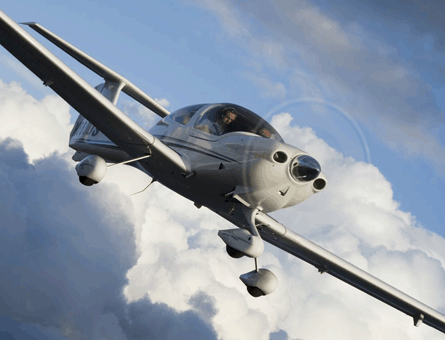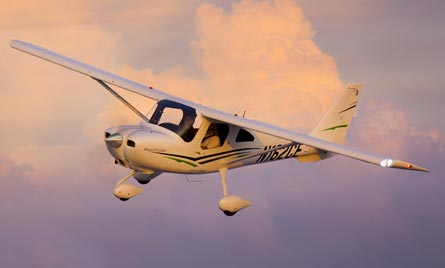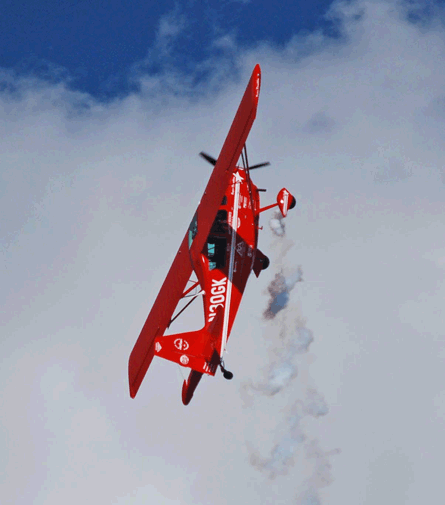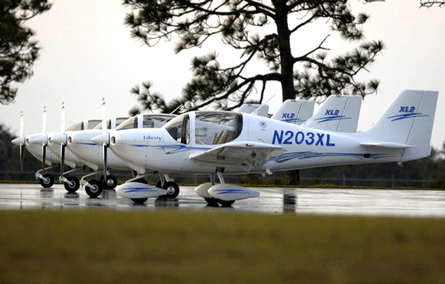Among all the sectors of the aerospace industry, the economic downturn seems to have hit piston aircraft manufacturers the hardest. While the turboprop, business jet and commercial aircraft sectors have also been affected, demand for pistons from private owners, flights schools and air taxi operators nearly evaporated in the second half of 2008, forcing every manufacturer to slow and in some cases even halt production.
Not surprisingly, piston deliveries according to figures from the General Aviation Manufacturers Association (GAMA), have since been in a nose dive. Last year only 965 piston aircraft were delivered, a 54% drop compared to 2008 and a 13-year low for a sector which for five consecutive years had delivered at least 2,000 aircraft. All 10 manufacturers that are still active in the sector posted large year-over-year drops (see chart) as the piston market had its worst showing since 1996, when 801 aircraft were delivered.
 |
|---|
© Diamond Aircraft |
Figures for the first quarter of 2010 were also bleak, with only 166 piston aircraft delivered. This represented a further 7% fall compared with the previous nadir in the first quarter of 2009 and a whopping 70% drop compared with the first quarter of 2007.
But piston manufacturers believe the bottom is now finally in the rear view mirror and most expect to post at least a slight improvement in deliveries for the entire year. A handful of manufacturers have already increased production, giving the industry a dose of optimism. But no one yet is willing to predict a full recovery and it could take several years for the industry to return to its 2006 peak, when 2,755 piston aircraft were delivered.
"We're definitely off bottom. We don't see it getting worse," Cirrus Design co-founder and chairman Dale Klapmeier says. "We're cautiously optimistic for the rest of the year."
Klapmeier adds that the pace of the recovery is slow but the market "is definitely coming back". Cirrus, the world's second largest piston aircraft manufacturer after Cessna, delivered 53 aircraft in the first quarter, up 36% from the 39 deliveries in the first quarter of 2009. But more importantly Klapmeier says order levels were double compared to the same period last year.
He says that for the full year Cirrus now expects deliveries to be up at least 20% compared with 2009, when it delivered 268 aircraft. Klampeier acknowledges the market has a long way to go before Cirrus can return to its 2006 and 2007 peak, when it delivered 721 and 710 aircraft respectively, but is confident the Minnesota-based manufacturer will eventually get there.
 |
|---|
"I believe we'll get back to that. GA makes sense. More people should be flying. GA will survive this and will recover," Klapmeier predicts.
He adds that Cirrus and other manufacturers have used the downturn to cut fat and become learner and more efficient organisations, which in the long run will help the overall health of the industry. "It's really tough when you go from 700 aircraft a year to less than half of that. It changes everything," Klapmeier says. "We've had to change the way we do business. But with the change the industry will be healthier. The entire industry has tightened its belt and is poised to be healthy again."
DEMAND RECOVERS
Piper Aircraft chief executive Kevin Gould says the Florida-based manufacturer has begun to benefit from a recovery in demand. Piper has already increased production twice this year and Gould says Piper now plans to produce at least 75% more piston and turboprop aircraft this year compared with 2009. Piper, according to GAMA figures, delivered only 61 piston aircraft last year, compared with 216 aircraft in 2008.
"We continue to get a lot of feedback from our dealers. They say there's more and more activity, which gives us the confidence to increase production rates even more," Gould says, adding a further increase in production is possible later this year.
But other manufacturers caution not to read too much into Piper's seemingly dramatic production increases because it was the most aggressive in its cuts. In fact, Piper's 72% year-over-year drop in deliveries last year was stepper than any of the six leading manufacturers and Gould acknowledges Piper is still a long way from returning to its 2008 output.
"It will take a crystal ball with the economy to say when we'll get back to 2008 levels," Gould says.
While Cessna and Hawker Beechcraft are now experiencing more sales activity, neither are quite yet ready to increase production. Cessna expects its 2010 delivery figures to be lower than 2009 while Hawker Beechcraft expects roughly flat figures.
 |
|---|
© Cessna |
"We wouldn't want to build too many airplanes. Too many airplanes isn't good for anyone," says Cessna vice-president worldwide propeller aircraft sales John Doman. "We experienced some of that last year. We want to get out of that situation, not into it."
Doman says after being stuck in an oversupply situation in 2008 and 2009, excess inventory levels are now "manageable" and stock levels at Cessna's dealers are at their lowest levels in several years. He says Cessna is continuing to gauge inventory levels and demand on a monthly basis but for now has no plans to increase production in 2010.
But Doman adds "we've definitely seen a resurgence in interest and activity in leads" across its piston production line. While overall production levels have not increased yet, he says there have been adjustments to the mix in response to a shortage in supply in certain models such as the Cessna 182. "It's hard to have a crystal ball in today's marketplace," Doman cautions.
 |
|---|
According to GAMA figures, Cessna delivered 354 piston aircraft in 2009, compared with 733 aircraft in 2008. In the first quarter of this year it delivered only 30 piston aircraft, compared with 46 aircraft in the same period last year. Cessna says for the full year it now plans to deliver 325 piston aircraft in 2010.
Hawker Beechcraft saw its piston deliveries slip a similar amount last year from 103 to 56 aircraft and it was only able to deliver five aircraft in the first quarter of this year. Echoing Doman, Beechcraft president Americas Keith Nadolski says that while the number of queries the manufacturer has fielded so far this year for its piston line has been "better than expected" it is not yet planning any increase in piston production.
"We're cautiously optimistic that perhaps we've seen the bottom. We are still planning for this year to be relatively flat but there is optimism out there now. People are talking to us about upgrading their aircraft. I feel very good about what I'm seeing," Nadolski says. "We are seeing in the customer base lots of conversation, lots of optimism. We don't see real growth yet but we got a lot of people talking to us and that's always good."
He adds improvement in the availability of financing, which was one of the sector's major challenges last year, and the recovering stock market are giving prospective buyers reason to go ahead with aircraft purchases they have been pondering. "We're not walking away from deals because a lack of financing. That's a very positive trend that even six months ago we weren't seeing," Nadolski says.
He says there is certainly no consideration of further cutting production as the current build and inventory rates for the Beechcraft line seem just about right. But while Hawker Beechcraft is optimistic it will eventually be able to increase production to previous levels - it averaged 114 piston deliveries from 1998-2008 - it is impossible to predict the steepness of the recovery curve.
"We're feeling pretty good about things," Nadolski says. "We feel the worse is over. We just don't know how good it's going to get or how quickly we are going to recover."
Mooney is also cautiously optimistic as it prepares to resume production. Faced with excess inventory at the onset of the economic downturn, Mooney halted production in November 2008 and furloughed all but 60 of its employees. Mooney early this year began taking deposits on 2010 models, providing some indication the manufacturer expects there will be enough demand to warrant restarting production by the end of the year.
"We have all intentions to restart production when demand is there," says international sales manager Susan Harrison.
Even though Mooney did not produce any new aircraft in 2009, GAMA figures show it still delivered 19 piston aircraft - 15 Acclaims and four Ovation 2s. These were aircraft left in Mooney's factory-owned excess inventory when production was halted. Harrison says the last aircraft from its excess inventory was delivered last December, prompting Mooney to begin looking at restarting production.
While Harrison says Mooney "has not yet seen any real indication" of a recovery, some of the sector's other small players believe the recovery is already under way.
 |
|---|
© American Champion |
American Champion, Maule and Liberty for example, say they are already experiencing enough resurgence in demand to increase their output.
Maule, after averaging over 40 deliveries a year from 1998 to 2008, only delivered seven aircraft in 2009. Director of sales and marketing Brent Maule expects the manufacturer in 2010 will at least match its 2006 and 2007 output, when it delivered 38 and 36 aircraft, respectively.
PRE-RECESSION LEVELS
"We want to be back to pre-recession levels," Maule says, adding if some international deals he is negotiating come though the Georgia-based manufacturer may even be ahead of these figures.
"The international market has been really good recently," he says. "A lot of countries' GAs are starting to flourish".
International sales now account for about half of Maule's business. Brent Maule says traditionally Maule has been in Europe, Latin America and Europe and "we're just now getting into Asia". He says Maule is now working on its first sale in decades in India and is looking at appointing new distributors throughout the region.
American Champion vice-president engineering Jerry Mehlhaff Jr says strong international demand is also driving a recovery at the small Wisconsin-based manufacturer. Mehlhaff says 50% of American Champion's deliveries are now overseas, compared with 10% historically. He says American Champion plans to deliver its first aircraft to India this year and there is particularly a lot of activity in Brazil and in other South American markets.
In response to the increased demand, American Champion has already increased production and returned all its employees to a full-time schedule after having reduced hours by 20%. Mehlhaff says American Champion is now producing one aircraft a week, up from a rate of two aircraft a month late last year.
"It's definitely improved," he says. "One kept on downsizing and downsizing. We're back up to full-time."
American Champion delivered only 26 aircraft in 2010, a reduction of more than 50% compared with the 52 delivered in 2009. Mehlhaff expects American Champion to produce 35-40 new aircraft in 2010 and says there is also a big pick up in its refurbishments business.
International sales are also fuelling the recovery at Liberty. Sales and marketing director Christina Mennen says while the private aircraft market remains slow, activity picked up in the first half of this year in the flight school sector. She says most of this demand is coming from Asian schools, including a Chinese school that recently took delivery of four Liberty XL2s.
As a result, Liberty expects to deliver at least 20 aircraft this year and is aiming to match its 2008 output of 33 aircraft. Last year the Florida-based manufacturer only delivered 13 aircraft.
 |
|---|
© Liberty Aircraft |
"Last year was a tough year. We're definitely expecting it to be better this year," Mennen says. "There's huge pilot demand in South-East Asia, so that's where a lot of the demand is coming from. Internationally we're doing really well."
Piper also reports surging demand from flights schools in Asia. The manufacturer expects to produce this year over 100 Seminole and Warrior trainers, with several batches of aircraft set for the Asian market. According to GAMA figures Piper delivered only 13 Warriors and Seminoles last year and 47 trainers in 2008.
"We see a lot of orders in the training segment. A lot of that is coming from overseas," Gould says, adding that while sales activity in traditional markets such as Europe and North America "is not skyrocketing, it's starting to come back".
Doman says Cessna also has had recent success in concluding fleet deals for Cessna 172s with schools overseas. "Generally the business is shifting from primarily what was a US marketplace," Doman says, adding that international markets now account for 40% of Cessna's deliveries compared with only 15% a couple of decades ago.
For now demand from flight schools is surpassing the owner-flown and air taxi markets. But as the economy improves, private sales are expected to pick up and most piston manufacturers still see potential in the battered air taxi market.
Cirrus in particular was heavily exposed to the bankruptcy of SATSair, a South Carolina-based air taxi company which operated 26 Cirrus SR22s before it ceased operations last October. Cirrus had to find new homes for many of these aircraft, which the manufacturer had owned and leased to SATSair in hopes of kick-starting the air taxi market, but Klapmeier continues to believe air taxi "is a market that in the end makes sense".
"Every business struggled last year. Some made it and some didn't. SATSair was absolutely the right idea," Klapmeier says. "They got caught up in bad timing. A lot of good concepts didn't make it in 2009."
Source: Flight International


























